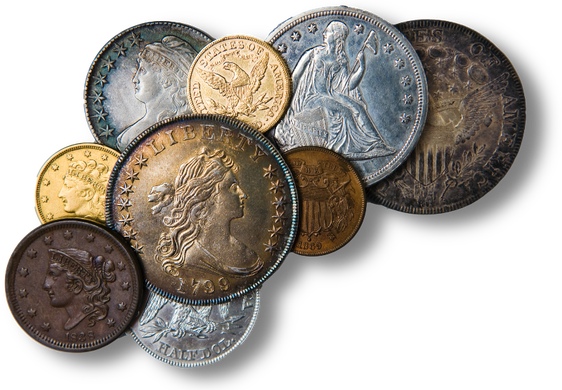
BACK TO STORYTELLING
April 7, 2020:
My COVID-19 downtime has given me the opportunity to work on some long-standing home renovation projects and also to confront a mystery that has vexed me for over two years.
My home was originally built in 1958 but has had at least two expansions over the intervening decades. The original footprint was small: a rectangular main room with two adjacent bedrooms and a tiny bathroom. Later, a garage was rebuilt to create the current kitchen and utility room; and subsequently a back patio was retrofitted into two additional bedrooms.
For the last two decades, the house was a rental property and a definite fixer-upper by the time I bought it. I have systematically upgraded everything from the electrical system to the doors, walls and flooring. It was while renovating the walls that I encountered my mystery.
With amazing regularity, I have found coins hidden behind the plaster, under baseboards and molding, and inside doorjambs. The coins have been recovered in both the original part of the house and the newer additions. In total, I’ve gathered over a dozen assorted quarters, nickels, dimes and pennies with the oldest readable date being 1968. Some coins appear to be even older, but were so degraded that the writing on them was unreadable.
It’s occurred to me that some of the change might’ve slipped out of the pockets of electricians crawling around in the attic, but this couldn’t possibly explain all of it. The coins hidden inside baseboards or door jambs, or wedged behind electrical boxes, had to be placed deliberately.
But why?
I began to wonder if I had uncovered some unspoken tradition among homebuilders? I mentioned this to several friends who have done construction, but no one had any theories about the coins. Then I remembered reading about similar practices during ancient times. I quick internet search confirmed a tradition probably as old as home-building itself.
A 2017 article from the New York Times read in part:
“The practice of burying or concealing items in the structure of a house is called immurement,” said Joseph Heathcott, an architectural historian and urbanist who teaches at the New School in New York.
“It is actually an ancient practice that cuts across many cultures and civilizations,” Dr. Heathcott added. The most famous examples are artifacts entombed with Egyptian pharaohs in the pyramids, but he said that ritual objects have often been found in the walls of Roman villas and ordinary houses during archaeological excavations. “The history of Freemasonry traces its origins to the rituals of concealment by masons, sealing up secrets in their buildings,” he said.
Needless to say, the excavation of old walls can reveal some fascinating treasures or even make someone rich.
In 2005, a Pennsylvania man found a trove of old coins in the walls of an abandoned house. The cache was worth up to $200,000 and the coins dated from 1826 to 1964. This is a rarity of course, and probably the Pennsylvania case was more likely a homeowner hiding his life savings than engaging in a superstitious ritual.
I went on to find several online forums where coin collectors and homebuilders actually spoke about the modern versions of this tradition, which varied in form depending on the part of the country was being discussed. In New England, for example, it was common to nail coins into the walls over the front door of a new house or barn. A separate forum spoke to the placement of coins behind baseboards.
Wrote one commentator: “I've always put a current year coin in any structure being built, like a barn or cabin. Don't know about baseboards, or any internal carpentry project but I could easily see the tradition applying to other parts of the construction process.I don't think of it as a superstition, more of a tradition. Besides, when you do repairs you can always be sure of when the original was built.”
More commonly, and reminiscent of the ancient Egyptian and Roman traditions, coins were placed inside concrete foundations as a way to bring luck to those who dwelled within.
Whatever the reason for the coins in my walls, I’m not going to get rich. What I’ve recovered comes to just over a dollar but maybe monetary value isn’t the point? The coins are a reminder of days and people long gone who lived under the same roof. And if they bring me luck in the process, even better.
I’ve been taking the coins out, but after thinking about it more, I’m going to put them back. Who am I to break such an old tradition, after all?
April 7, 2020:
My COVID-19 downtime has given me the opportunity to work on some long-standing home renovation projects and also to confront a mystery that has vexed me for over two years.
My home was originally built in 1958 but has had at least two expansions over the intervening decades. The original footprint was small: a rectangular main room with two adjacent bedrooms and a tiny bathroom. Later, a garage was rebuilt to create the current kitchen and utility room; and subsequently a back patio was retrofitted into two additional bedrooms.
For the last two decades, the house was a rental property and a definite fixer-upper by the time I bought it. I have systematically upgraded everything from the electrical system to the doors, walls and flooring. It was while renovating the walls that I encountered my mystery.
With amazing regularity, I have found coins hidden behind the plaster, under baseboards and molding, and inside doorjambs. The coins have been recovered in both the original part of the house and the newer additions. In total, I’ve gathered over a dozen assorted quarters, nickels, dimes and pennies with the oldest readable date being 1968. Some coins appear to be even older, but were so degraded that the writing on them was unreadable.
It’s occurred to me that some of the change might’ve slipped out of the pockets of electricians crawling around in the attic, but this couldn’t possibly explain all of it. The coins hidden inside baseboards or door jambs, or wedged behind electrical boxes, had to be placed deliberately.
But why?
I began to wonder if I had uncovered some unspoken tradition among homebuilders? I mentioned this to several friends who have done construction, but no one had any theories about the coins. Then I remembered reading about similar practices during ancient times. I quick internet search confirmed a tradition probably as old as home-building itself.
A 2017 article from the New York Times read in part:
“The practice of burying or concealing items in the structure of a house is called immurement,” said Joseph Heathcott, an architectural historian and urbanist who teaches at the New School in New York.
“It is actually an ancient practice that cuts across many cultures and civilizations,” Dr. Heathcott added. The most famous examples are artifacts entombed with Egyptian pharaohs in the pyramids, but he said that ritual objects have often been found in the walls of Roman villas and ordinary houses during archaeological excavations. “The history of Freemasonry traces its origins to the rituals of concealment by masons, sealing up secrets in their buildings,” he said.
Needless to say, the excavation of old walls can reveal some fascinating treasures or even make someone rich.
In 2005, a Pennsylvania man found a trove of old coins in the walls of an abandoned house. The cache was worth up to $200,000 and the coins dated from 1826 to 1964. This is a rarity of course, and probably the Pennsylvania case was more likely a homeowner hiding his life savings than engaging in a superstitious ritual.
I went on to find several online forums where coin collectors and homebuilders actually spoke about the modern versions of this tradition, which varied in form depending on the part of the country was being discussed. In New England, for example, it was common to nail coins into the walls over the front door of a new house or barn. A separate forum spoke to the placement of coins behind baseboards.
Wrote one commentator: “I've always put a current year coin in any structure being built, like a barn or cabin. Don't know about baseboards, or any internal carpentry project but I could easily see the tradition applying to other parts of the construction process.I don't think of it as a superstition, more of a tradition. Besides, when you do repairs you can always be sure of when the original was built.”
More commonly, and reminiscent of the ancient Egyptian and Roman traditions, coins were placed inside concrete foundations as a way to bring luck to those who dwelled within.
Whatever the reason for the coins in my walls, I’m not going to get rich. What I’ve recovered comes to just over a dollar but maybe monetary value isn’t the point? The coins are a reminder of days and people long gone who lived under the same roof. And if they bring me luck in the process, even better.
I’ve been taking the coins out, but after thinking about it more, I’m going to put them back. Who am I to break such an old tradition, after all?




